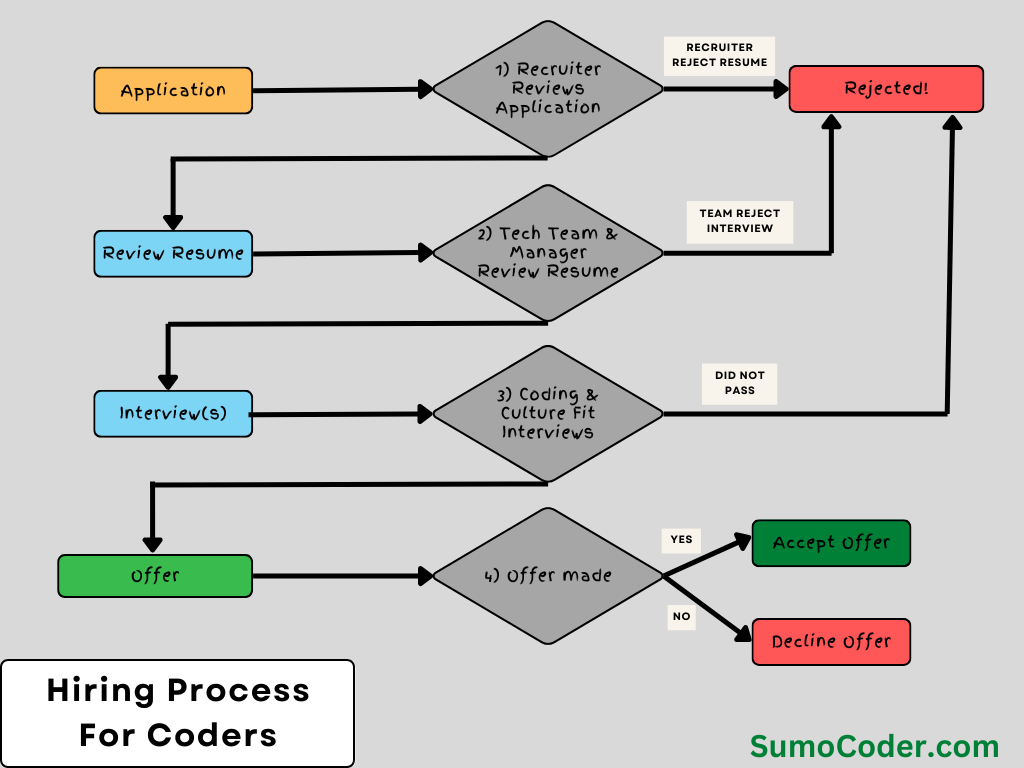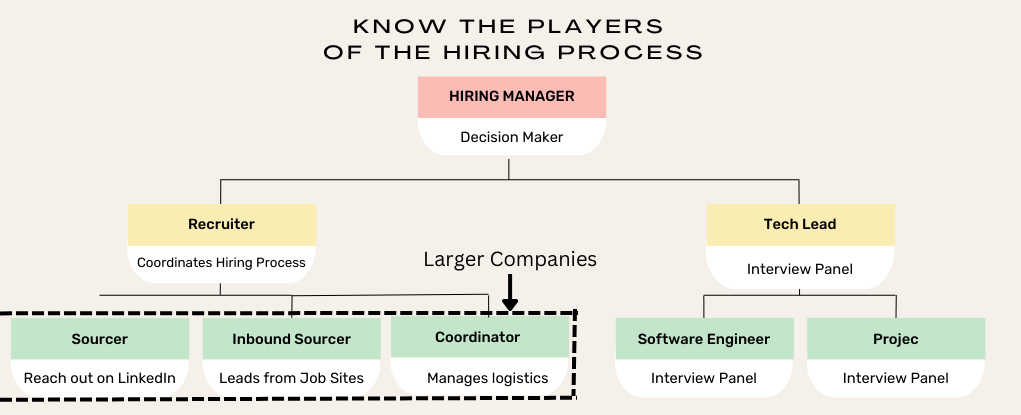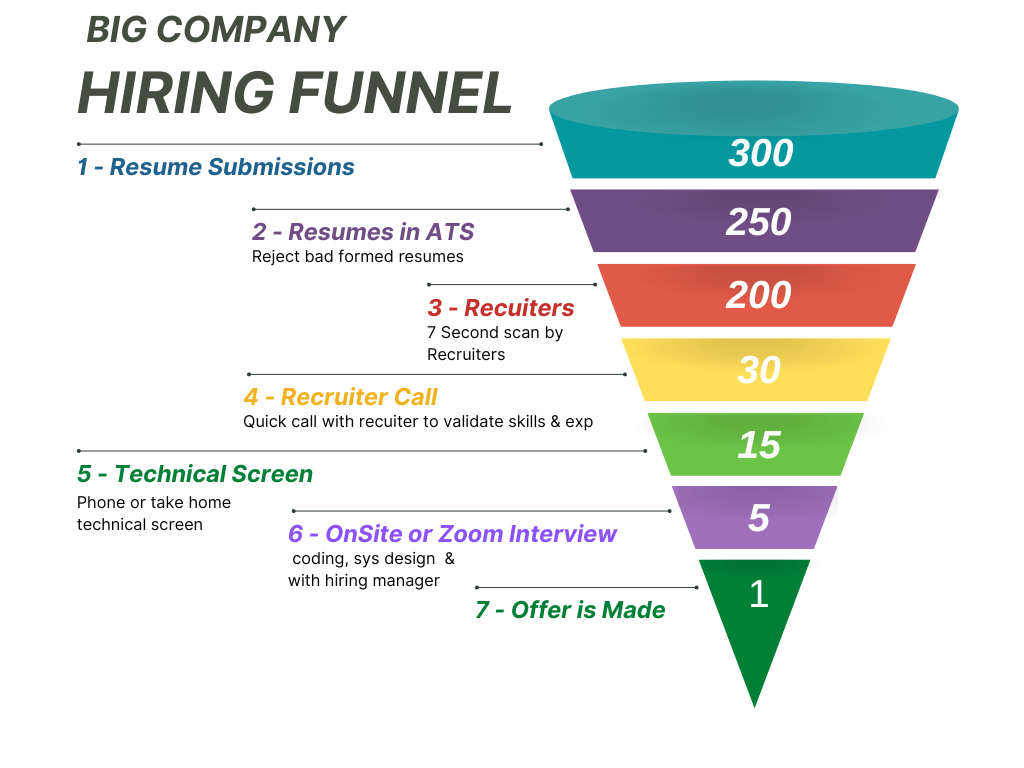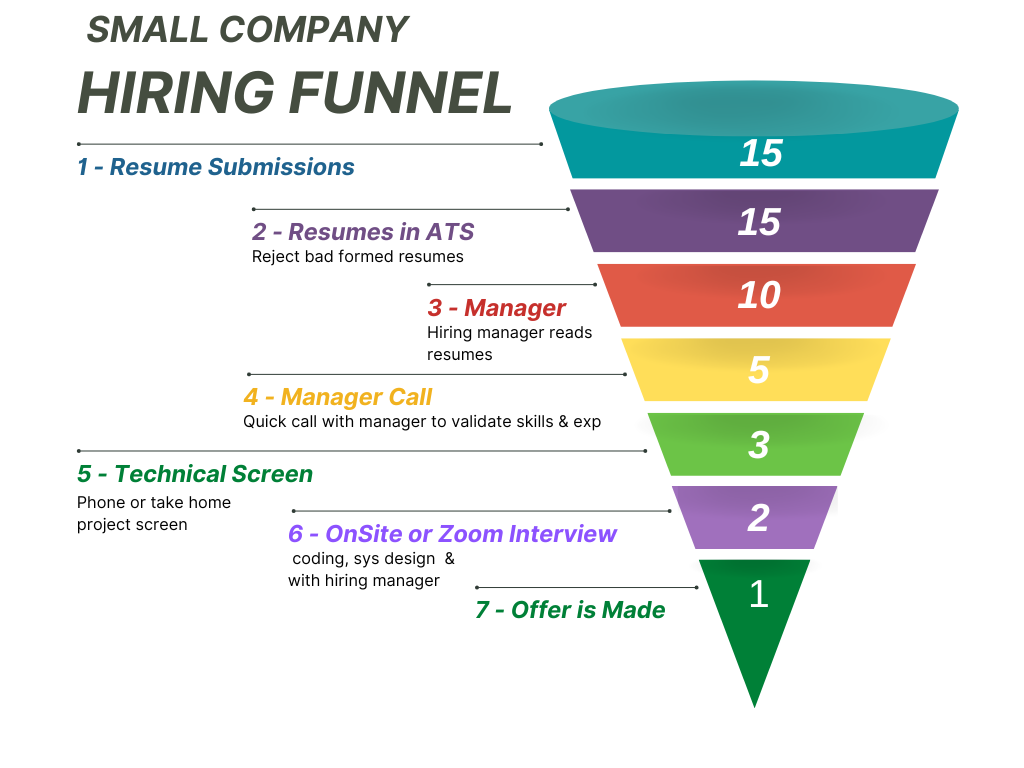- Home
- Software Engineer Career
- Hiring Process
Uncovering the Software Engineer Hiring Process
Welcome to the game of the software engineer hiring process!! One I've played many times in my 20+ years at companies of all sizes (from 6 to +50,000 employees). Mastering the game requires you have a solid high-level overview of the hiring process, which does vary from company to company. Some companies may have additional steps or may do things in a different order but that's fine as we'll cover what the ATS really is, the key players in the game, and what the big company hiring funnel and small company hiring funnels look like.

Software Engineering Hiring Process Essentials
The software engineer hiring process generally follows this process:
- Resume/cover letter review: The recruiter (or hiring manager for small companies) will review resumes (and maybe cover letters) to determine top candidates that meet minimum qualifications for the role. (Note: the average review time for recruiters especially at large firms is SEVEN seconds according to this study: https://www.hrdive.com/news/eye-tracking-study-shows-recruiters-look-at-resumes-for-7-seconds/541582/) so make it SHINE!
- Initial screening: Next step may be a quick phone or video call with a member of the recruiter or hiring manager for small companies. This is to get a better understanding of your skills, experience, and to determine if you're are a good fit for the role.
- Technical screening: If you pass the initial screening you may have a technical screening, which may involve completing a technical assessment or coding challenge. This is to quickly filter out people who can't code at all (this is NOT you is it?)
- Interviews: This is the moment you've been waiting and preparing for. Technical interviews! These interviews may be conducted in person, or via video call. You'll have an interview with the hiring manager to make sure it's a good culture fit as well
- Offer: Kudos for anyone who makes it here and you get a chance to negotiate your offer! (this is where you have the most leverage as the company already did the hard work to decide you're worth it! So use it!)
The ONLY thing you need to know about ATS (Applicant Tracking Systems)
There are a ton of “resume ATS optimization” services and/or software. At the time of this writing (2023) the ATS does NOT automatically filter candidates. People at tech companies do NOT trust the software to reject candidates for them. Meaning ATS is just a database to store and process resumes, nothing more. So, ignore any services that say they can ‘crack’ the ATS for resumes.
The KEY Players of the Software Engineer Hiring Process

You gotta know who the players are if you want to crush the software engineer hiring process! Just like playing poker:
“If you've been playing poker for half an hour and you still don't know who the patsy is, you're the patsy.”
― Warren Buffett
If there's ONE thing I can share it's this: The hiring manager is the most important person in the recruitment process. After all, they’re the ones that open job positions and have the final say on who gets hired. They can bend HR to their will. (I even had a job where I was lowballed by some +$30,000 - however, since I had a good relationship with the hiring manager, I was able to negotiate and close that gap). if at all possible, know and meet this person BEFORE the interview even happens.
Next up is the recruiter. This person is like the hiring manager's "best friend" in the software engineer hiring process. They contact solid candidates that meet the hiring manager's criteria and go over the interview process. I've found a lot of times if the recruiter is disorganized and frantic, usually, the company's culture is. Also, the inverse is true, I had my first recruiter screen (in person which is unusual) with Slalom Consulting and initially wasn't really that interested - until I saw how sharp the recruiter was. (I got the job after about 7 interviews - brutal but worth it!)
The interview panel are gonna be your buddies as they're the engineers who do the dreaded technical interviews. Again, the hiring manager makes the call. One of the candidates flat-out failed my tech interview at an insurance company but STILL got the offer - that's how powerful they are!! (he was terrible but again it pays to know the hiring manager BEFORE the interview!)
Note: At small companies, however you may do an online coding test and will only have one interview with the hiring manager.
The next 3 players work behind the scenes and you will likely never see them during the interview process but it's good to understand the roles they play in the game:
The sourcer looks for candidates on websites like LinkedIn and talk to people to get them interested in the job. Once they find someone who looks good, they give them to the recruiter. Their goal is to get as many qualified people in the pipeline as possible.
The inbound sourcer goes over job applications from people who applied. They look at all the applications, prioritize referrals, and pass qualified candidates to the recruiter.
The recruitment coordinator manages the process. Their job is to schedule interviews and make sure everyone is on time.
Typical Funnel Numbers for Large Companies

Applicant Tracking System Queue. Most big companies use an ATS - which is just a database. Some applications might not be looked at because there are already enough qualified resumes in the previous batch or the position has just been filled.
In a nutshell, the later your resume comes in, the lower the chance it will be looked at. SO ACT FAST!
Resume Screen. For most companies, recruiters do the resume screening. The recruiter or inbound sourcer scans your resume (7 seconds) to determine if you might be a fit for the position. If you're not you may get an automated rejection message—if you're lucky (you may never even hear from them) If the first scan is promising, they'll spend a bit more time reading your resume in depth.
This is where the bigget dropoff of resumes happen. From hundreds of resumes, only a few dozen profiles tend to have a recruiter screening call. Why you MUST GRAB THE RECRUITER'S ATTENTION with A KILLER RESUME!
Typical Funnel Numbers for Small Companies
 Note: at companies that are very small or have minimal resources to spend on hiring, the hiring manager often does all the work. This includes the resume screen, the screening call, and coordinating the onsite interviews.
Note: at companies that are very small or have minimal resources to spend on hiring, the hiring manager often does all the work. This includes the resume screen, the screening call, and coordinating the onsite interviews.Recruiter Screen. Only profiles that look like a promising fit for the job make it to the recruiter screen. This is a phone call with the recruiter, confirming experience, motivation, and touching on soft skills.
Technical Screen. A technical phone screen and/or a take-home challenge focused on coding. Candidates almost always interact with software engineers at the company at this point.
Onsite Interview. Yep here you'll get grilled in your coding, and systems design skills for advance roles. Then you'll give the hiring manager a chance to showcase your amazing people skills and values alignment. (you if you do a LITTLE homework you should breeze the behavioral interviews)
Offer. Dude if you get an offer, seriously congratulations! You may have been competing with hundreds of other people for one offer. You may not have had much of a clue until now just how competitive the software engineer hiring process was.